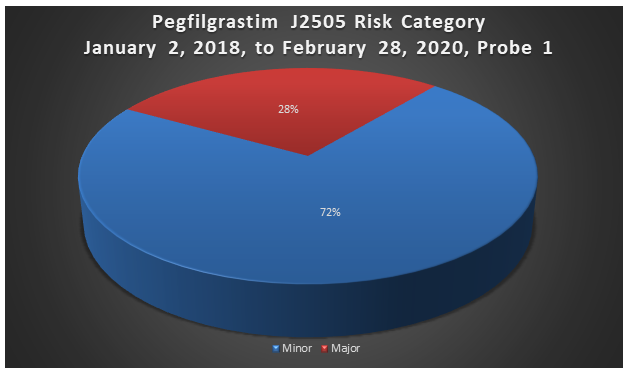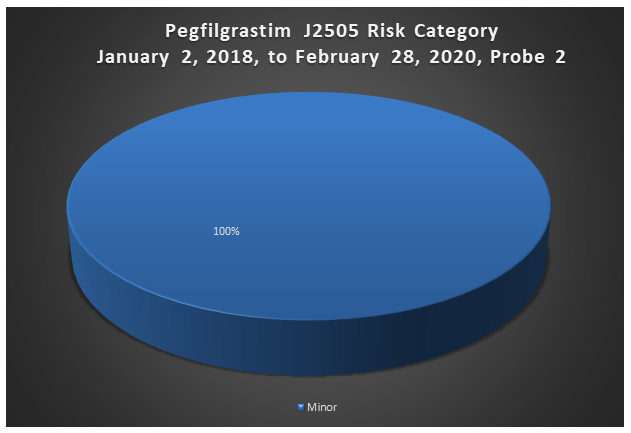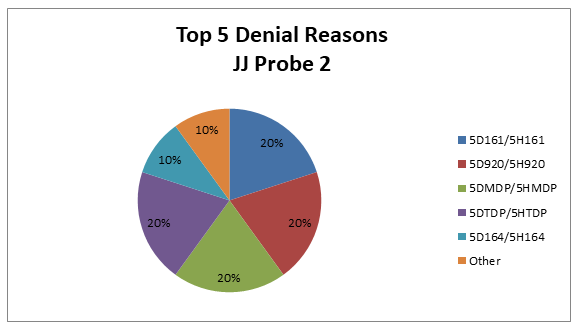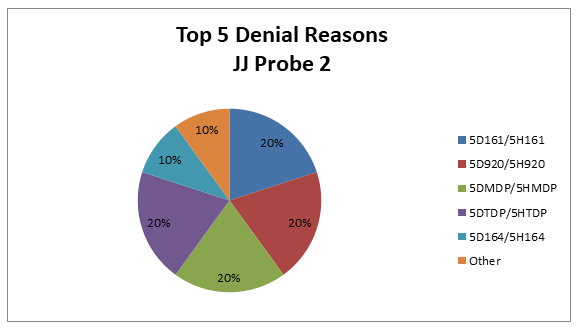Targeted Probe and Educate Progress Update: JJ Part A - Pegfilgrastim J2505
The Centers for Medicare & Medicaid Services (CMS) Change Request 10249 (PDF, 241.88 KB) implemented the Targeted Probe and Educate (TPE) process, effective October 1, 2017. The following provides JJ Probe 1 and Probe 2 TPE results statistics from January 2, 2018, to February 28, 2020.
Findings
Medical Review initiated Probe review edits for providers identified through data analysis demonstrating high risk for improper payment. Providers have been offered education throughout and upon completion of the JJ Probe 1 and Probe 2 TPE review. Current JJ Part A Probe 1 and Probe 2 Pegfilgrastim J2505 TPE Results are as follows:
Pegfilgrastim J2505
Probes Processed January 2, 2018, to February 28, 2020
| Number of Providers with Edit Effectiveness Performed Probe 1 | Providers Compliant Completed/ Removed After Probe 1 | Providers Non-Compliant Progressing to TPE Probe 2 |
Providers | Number of Providers with Edit Effectiveness Performed Probe 2 | Providers Compliant Completed/ Removed After Probe 2 | Providers Non-Compliant Progressing to TPE Probe 3 |
|---|---|---|---|---|---|---|
|
32 |
23 |
9 |
3 |
3 |
0 |
0 |
Findings by State
Palmetto GBA’s overview of results by state, for providers who have had edit effectiveness performed for JJ Probe 1 and Probe 2 TPE review from January 2, 2018, to February 28, 2020.
| State | Number of Providers with Edit Effectiveness Performed Probe 1 | Providers Compliant Completed/ Removed After Probe 1 | Providers Non-Compliant Progressing to TPE Probe 2 | Providers Removed from Probe 1 and 2 for Other Reasons | Number of Providers with Edit Effectiveness Performed Probe 2 | Providers Compliant Completed/ Removed After Probe 2 | Providers Non-Compliant Progressing to TPE Probe 3 |
|---|---|---|---|---|---|---|---|
| Alabama |
9 |
4 |
5 |
0 |
3 |
3 |
0 |
| Georgia |
13 |
9 |
4 |
0 |
0 |
0 |
0 |
| Tennessee |
10 |
10 |
0 |
0 |
0 |
0 |
0 |
| State | Overall Charge Denial Rate Per State Probe 1 | Overall Charge Denial Rate Per State Probe 2 |
|---|---|---|
| Alabama |
17% |
4% |
| Georgia |
14% |
N/A |
| Tennessee |
3% |
N/A |
Risk Category
Risk Category is defined based on end of JJ Probe 1 provider error rates. The categories are defined as:
| Risk Category | Error Rate |
|---|---|
|
Minor |
0–20% |
|
Major |
21–100% |

Risk Category
Risk Category is defined based on end of JJ Probe 2 provider error rates. The categories are defined as:
| Risk Category | Error Rate |
|---|---|
|
Minor |
0–20% |
|
Major |
21–100% |

Pegfilgrastim J2505 Probe 1
Top 5 Denial Reasons January 2, 2018, to February 28, 2020
- 5DMDP/5HMDP — Dependent Services Denied (Qualifying Service Denied Medically)
- 5D920/5H920 — The Recommended Protocol Was Not Ordered and/or Followed
- 5D161/5H161 — No Physician’s Orders
- 5D164/5H164 — No Documentation of Medical Necessity
- 5DTDP/5HTDP — Dependent Services Denied (Qualifying Service Denied Technically)

Pegfilgrastim J2505 — Probe 2
Top 5 Denial Reasons January 2, 2018, to February 28, 2020
- 5D161/5H161 — No Physician’s Orders
- 5D920/5H920 — The Recommended Protocol Was Not Ordered and/or Followed
- 5DMDP/5HMDP — Dependent Services Denied (Qualifying Service Denied Medically)
- 5DTDP/5HTDP — Dependent Services Denied (Qualifying Service Denied Technically)
- 5D164/5H164 — No Documentation of Medical Necessity

DMDP/5HMDP — Dependent Services Denied (Qualifying Service Denied Medically)
Reason for Denial
The dependent services will not be covered if the qualifying surgery has been denied. For example, the surgical procedure was denied as documentation did not support medical necessity, therefore all other charges cannot be allowed and will be denied as dependent to the medical denial of the qualifying service.
How to Avoid a Denial
Documentation that may be helpful to avoid future denials for this reason may include, but is not limited to, the following:
- All documentation to support orders, documentation of services rendered and documentation of medical necessity for the qualifying services for the date(s) billed
5D920/5H920 — The Recommended Protocol Was Not Ordered and/or Followed
Reason for Denial
Medicare cannot pay for this service because one or more requirements for coverage were not met.
How to Avoid a Denial
Documentation that may be helpful to avoid future denials for this reason may include, but are not limited to, the following:
- Clear physician’s order with indication of need, dose, frequency and route
- Date and time of associated chemotherapy, as applicable
- Relevant history and physical and/or progress notes
- Clear indication of the diagnosis
- Clinical signs and symptoms
- Prior treatment and response as applicable
- Stage of treatment as applicable
- Documentation of administration
5D161/5H161 — No Physician’s Orders
Reason for Denial
This claim was fully or partially denied because there were no physician’s orders submitted for review for all or some of the services billed.
How to Avoid a Denial
- A physician’s order should be submitted for review with the request for copies of medical records
- A legible signature is required on all documentation necessary to support orders and medical necessity
- The copy of the order should be legible and dated
- Make sure any orders submitted for review are for the dates of service billed
5D164/5H164 — No Documentation of Medical Necessity
Reason for Denial
This claim was fully or partially denied because the documentation submitted for review does not support the medical necessity of some of the services billed.
How to Avoid a Denial
- Submit all documentation related to the services billed which support the medical necessity of the services
- A legible signature is required on all documentation necessary to support orders and medical necessity
- Use the most appropriate ICD-10-CM codes to identify the beneficiary’s medical diagnosis
5DTDP/5HTDP — Dependent Services Denied (Qualifying Service Denied Technically)
Reason for Denial
The dependent services will not be covered if the qualifying surgery has been denied. For example, the surgical procedure was not documented, therefore all other charges cannot be allowed.
How to Avoid a Denial
Documentation that may be helpful to avoid future denials for this reason may include, but is not limited to, the following:
- All documentation to support orders, documentation of services rendered and the medical necessity of qualifying services for the date(s) billed
Education
Providers are offered an individualized education session where each claim denial will be discussed, and any questions will be answered. Palmetto GBA offers a variety of methods for provider education such as webinar sessions, web-based presentations, or teleconferences. Other education methods may also be available.
Next Steps
Providers found to be non-compliant (major risk category/denial rate of 21–100%) at the completion of TPE Probe 1 will advance to Probe 2, and providers found to be non-compliant (major risk category/denial rate of 21–100%) at the completion of TPE Probe 2 will advance to Probe 3 of TPE at least 45 days from completion of the 1:1 post probe education call date. Palmetto GBA offers education at any time for providers. Providers do not have to be identified for TPE to request education.
References
- CMS Targeted Probe and Educate (TPE) web page
- Change Request 10249 (PDF, 241.88 KB)